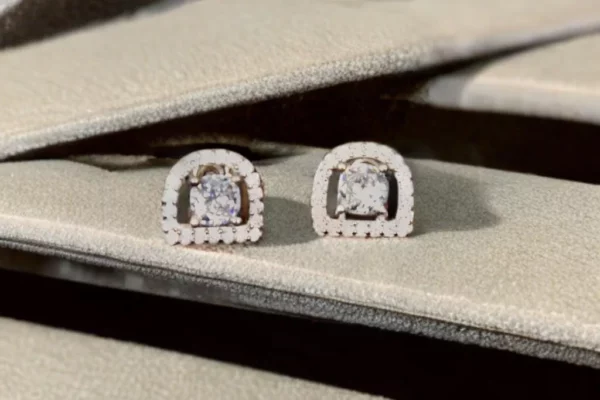Your cart is currently empty.
Diamond Origins & Global Presence: A Comparative Study

Diamonds have long been cherished for their timeless beauty and enduring allure. However, the diamond landscape has evolved, with the emergence of American diamonds providing a compelling alternative to natural diamonds. In this blog post, we’ll delve into the characteristics, differences, and considerations of American diamonds versus their natural counterparts, helping you make an informed choice when it comes to selecting the perfect gemstone for your jewellery.
American Diamonds: The Sparkling Contender
American diamonds, also known as cubic zirconia (CZ), are synthetic gemstones renowned for their brilliance and affordability. Here’s why they stand out:
- Affordability: American diamonds offer a budget-friendly option without compromising on sparkle. They provide a glamorous look at a fraction of the cost of natural diamonds, making high-quality jewellery accessible to a wider audience.
- Brilliance: With their high refractive index, American diamonds dazzle with intense sparkle and fire, rivaling that of natural diamonds. Their flawless clarity and precision-cut facets contribute to their captivating allure.
- Variety: American diamonds come in a diverse range of shapes, sizes, and colors, allowing for creative and customizable jewellery designs. From classic solitaires to intricate settings, the versatility of American diamonds knows no bounds.
- Durability: Despite being synthetic, American diamonds are durable and scratch-resistant, making them suitable for everyday wear. Their hardness rating is approximately 8.5 on the Mohs scale, ensuring long-lasting beauty.

Natural Diamonds: Timeless Beauty
Natural diamonds, formed deep within the Earth over millions of years, hold a special place in the hearts of jewellery enthusiasts. Here are some key features of natural diamonds:
- Authenticity: Natural diamonds are prized for their rarity and authenticity. Each natural diamond is a unique masterpiece of nature, with its own distinct characteristics, including color, clarity, and cut.
- Value: Natural diamonds retain their value over time and are often considered a symbol of prestige and luxury. Their scarcity and enduring beauty contribute to their high market value and investment potential.
- Emotional Significance: Natural diamonds are imbued with symbolism and sentiment, making them popular choices for engagement rings, wedding bands, and heirloom pieces. They carry the weight of tradition, love, and commitment.
- Ethical Considerations: Some individuals prefer natural diamonds due to ethical concerns surrounding the mining and production of synthetic gemstones. Natural diamonds sourced from reputable suppliers with ethical mining practices offer peace of mind for conscientious consumers.

Choosing Between American Diamonds and Natural Diamonds
When deciding between American diamonds and natural diamonds, several factors come into play:
- Budget: If budget is a primary consideration, American diamonds offer an affordable yet glamorous option. They allow you to achieve the look of luxury without breaking the bank.
- Preference: Some individuals prefer the authenticity and prestige associated with natural diamonds, while others appreciate the versatility and affordability of American diamonds. Personal preference plays a significant role in the decision-making process.
- Occasion: The occasion for which the jewellery is intended may influence your choice of diamond. For everyday wear or casual occasions, American diamonds offer a practical and stylish choice. For milestone events or special celebrations, natural diamonds may hold greater significance.
Geographical Properties of both American Diamonds and Natural Diamonds:
American Diamonds (Cubic Zirconia):
- Manufactured: American diamonds, also known as cubic zirconia (CZ), are synthetic gemstones created in laboratories using a process called the Verneuil method or the cubic press method. These laboratories are often located in various countries around the world where gemstone synthesis is practiced.
- Global Availability: Due to their synthetic nature, American diamonds are produced in controlled environments in laboratory facilities worldwide. They are widely available in the global market and can be manufactured to meet specific demand.
- Raw Material Sourcing: The raw materials used to create American diamonds, such as zirconium oxide and other elements, are sourced from various regions across the globe where these minerals are abundant.
- Manufacturing Facilities: Laboratories specializing in the synthesis of American diamonds are typically found in countries with advanced technological infrastructure and expertise in gemstone production, including the United States, Russia, China, India, and European countries.
Natural Diamonds:
- Geological Formation: Natural diamonds are formed deep within the Earth’s mantle under intense pressure and high temperatures over millions of years. They are brought to the Earth’s surface through volcanic eruptions or by the movement of tectonic plates.
- Primary Deposits: Natural diamond deposits are found in specific geological formations known as kimberlite pipes and lamproite pipes. These formations are located in various regions around the world, including Africa, Australia, Russia, Canada, and parts of South America.
- Secondary Deposits: In addition to primary deposits, natural diamonds are also found in secondary deposits such as alluvial deposits, riverbeds, and coastal areas. These secondary deposits are formed through the erosion and transport of diamonds from their original source rocks to new locations by natural processes like rivers and glaciers.
- Mining Operations: Natural diamond mining operations are conducted in countries with significant diamond reserves and mining infrastructure. Major diamond-producing countries include Botswana, Russia, Canada, South Africa, Australia, and Angola.
- Diamond Trade Hubs: Diamonds mined from various regions are traded and processed in major diamond trade hubs such as Antwerp (Belgium), Mumbai (India), Dubai (UAE), Tel Aviv (Israel), and New York City (USA). These hubs serve as centers for diamond cutting, polishing, and trading activities.
While American diamonds are synthetically produced in laboratory facilities worldwide using advanced technology, natural diamonds are formed naturally deep within the Earth’s crust and are mined from specific geological formations in various regions across the globe. Each type of diamond has its unique characteristics and geographical properties, contributing to its distinctiveness and value in the jewellery market.


